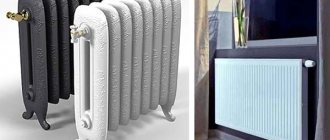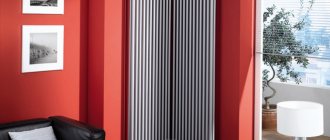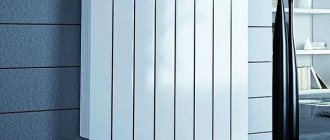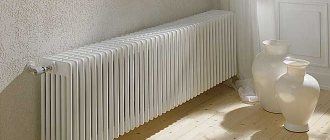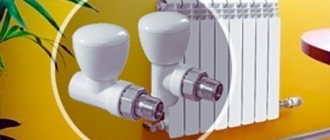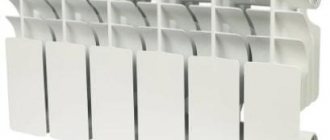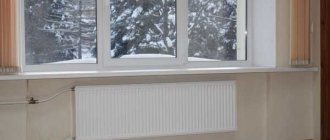There are three main points when choosing a radiator: material of manufacture, power (size, number of sections), aesthetics (how the heating device will look in the interior). The material from which the radiator is made affects the heat transfer of the battery, its weight and durability.
Heating appliances are mainly made of four types of materials and can be: cast iron; aluminum; bimetallic; steel.
The most popular for private homes are steel batteries, which have low inertia and have increased heat transfer. These heating elements are primarily selected according to size (width, height) and, accordingly, power, type (depth), design and coating. Each manufacturer produces several types of radiators, depending on the depth of steel panel radiators
there are:
- Single-panel, without convective fins, side strips and top decorative grille;
- Single-panel with convector and cladding;
- Double-panel with convector and side linings, grill type grill;
- Double-panel with two rows of convective fins, side strips and grille;
- Three-panel with three convectors, facing plates and grille;
- Four-panel (for example, Purmo Ventil Compact 44 with a height of 200 mm).
General characteristics of Kermi (Germany) and Purmo (Finland) equipment
Kermi steel heating radiators resist corrosion processes well.
Steel panel heating elements produced by Purmo and Kermi are universal equipment. It has proven itself well both in a centralized closed-type heating system and for heating houses in the private sector, that is, when organizing a private circuit, also of a closed type. Radiators can work with a single-pipe or two-pipe system, where the coolant is water. The equipment can withstand operating pressure of 7-8 atm, pressure testing - 13 atm. Thanks to double painting of both the outer and inner surfaces, these batteries resist corrosive processes and therefore have a long service life. All devices are compact and have a universal design, which helps them fit harmoniously into any room interior.
Heaton steel radiators - a combination of high quality and affordable cost
The manufacturer of these heating system elements is the international holding company Santekhkomplekt. The reliability for which Heaton radiators is ensured by the use of high-strength cold-rolled steel. Individual links of radiators with elongated U-shaped fins are connected to each other by creating spot or seam welding fasteners.
Heaton steel radiators with mixed radiation-convective heat transfer can withstand a pressure of 13 atm. And to increase their corrosion resistance, an enamel coating of RAL 9010 is used, which is subjected to final processing - baking in an oven (to increase the level of strength).
Characteristics of the model range of equipment produced by Kermi (Germany)
Consumer surveys have shown that equipment from Kermi (Germany) is relatively popular in Russia, and these steel batteries have received special attention thanks to:
Characteristics of standard sizes – panel steel batteries Kermi (Germany)
Kermi steel heating radiators have a high level of heat transfer.
The device consists of two steel panels welded together. Channels through which the coolant circulates are squeezed out. To increase heat transfer, U-shaped ribs are welded on the back side of each panel. They can be made in several rows; both the size of the radiator and its power depend on this. The entire structure is covered with decorative strips on top and sides. They increase the decorative value of the device.
Each panel radiator produced by Kermi Russia has a specific marking. From it you can determine the size of the device, its power, and structure.
So, today Kermi panel batteries are found with the following markings. Batteries marked type 10 indicate the presence of only one panel. Such a device will fit perfectly into the cramped passage of a small apartment. Next comes type 21 - it has two panels, between which there is one fin, type 22 - two panels and two rows of finned convectors, type 33 - respectively, three rows of fins and three steel panels.
Regarding the sizes. In general, equipment manufactured by Kermi (Germany) is produced in heights of 300-900 mm, width - 400-3000 mm, radiator depth - 45-158 mm.
Review of the model range - steel, panel batteries from Kermi (Germany)
Kermi heating devices today on the Russian market can be found in the following lines:
Kermi radiators are slightly more expensive than Purmo.
Important! Unlike products from Purmo (Finland), panel steel heating radiators from Kermi (Germany) are slightly more expensive.
Which is the best heating radiator for a private home?
Radiators are the final devices in the autonomous heating system of a cottage, large mansion or any private home. The choice of radiators of a certain class and type largely depends on what building material the building is constructed from.
If we take into account that houses are made of stone, brick, reinforced concrete and wood, then the requirements for batteries will differ.
Choosing a heating radiator// FORUMHOUSE
Stone, brick, block, reinforced concrete
Houses made of masonry building materials have a high degree of fire safety and moisture resistance. It is better to install radiators of an autonomous water heating system in them. Gas and electric boilers have greater efficiency than solid-liquid fuel equipment.
In this case, it is better to choose panel, sectional steel and aluminum water radiators.
With boiler equipment running on solid and liquid fuels, tubular, bimetallic and plate batteries will be quite suitable for heating.
Wooden private houses
Water heating is not installed in frame-panel houses and log houses. This is due to the fact that in the event of a pipeline break, the wood will quickly become saturated with moisture and eventually become completely functionally unusable.
Although there are exceptions, despite the great risk. Therefore, electric radiators are used for heating wooden housing constructions.
These include electric vacuum batteries and quartz panels.
Equipment from Finnish manufacturer Purmo Russia
Russian consumers receive steel panel heating devices made in Poland, although this product is in no way inferior in quality to the original. Thus, today Purmo radiators are represented by several model lines, which are characterized by their own structural and operational features.
Review of the Purmo radiator range (Finland) Russia
Purmo heating devices, like the equipment of the previous manufacturer, are made of steel panels 1.25 mm thick. The following types are available: 10, 11, 22, 21, 33, 30. Dimensions vary between: height - 300-900 mm, length - 400-3000 mm, depth - up to 158 mm.
The following panel heating elements are popular on the Russian market:
Source
Which steel radiators are better: manufacturer ratings
Heating batteries are presented on the shelves of specialized stores in many models. How to choose a heating radiator, what types they are, how they differ, what to look for when buying so that your home is warm and cozy. Which steel radiators are better in terms of quality, price, design and a number of other factors.
There are three main points when choosing a radiator: material of manufacture, power (size, number of sections), aesthetics (how the heating device will look in the interior). The material from which the radiator is made affects the heat transfer of the battery, its weight and durability.
Heating appliances are mainly made of four types of materials and can be: cast iron; aluminum; bimetallic; steel.
The most popular for private homes are steel batteries, which have low inertia and have increased heat transfer. These heating elements are primarily selected according to size (width, height) and, accordingly, power, type (depth), design and coating. Each manufacturer produces several types of radiators, depending on the depth of steel panel radiators
there are:
Types of radiators
Among the huge variety of models, the consumer faces the problem of which heating batteries are best to choose for an apartment and which ones for a private home.
Types of batteries can be grouped according to the following characteristics.
- Material of manufacture;
- Device shape and placement method.
Material of manufacture
Heating devices are:
- cast iron;
- steel;
- aluminum;
- bimetallic;
- copper;
- plastic.
Cast iron
Sections of the first cast iron heating radiators can still be seen in old apartment buildings built during the Soviet period. The appearance left much to be desired. They were quite bulky and did not in any way decorate the interiors of the apartments.
Modern devices of this type have a stylish design and high heat output . Thanks to the cast iron structure, the radiator can withstand a critical pressure level of up to 30 atmospheres (A), which saves it from powerful water hammer and rupture of the housing.
Cast iron heats up quickly and releases heat slowly.
Better cast iron batteries for an apartment
Cast iron products are “tolerant” of water quality and can withstand many years of operation with contaminated coolant. Thanks to the design, the batteries can be assembled and disassembled by varying the number of sections.
Steel
It is recommended to install a steel radiator in the apartment. They compare favorably with their cast iron “brothers” by being light in weight.
A significant disadvantage is susceptibility to corrosion.
The devices are designed for a maximum coolant temperature of 900 C. Steel batteries come in tubular and panel types. Both have a high degree of heat transfer.
They heat up almost twice as fast as their cast iron counterparts, but they also cool down just as quickly. At the end of the heating season, water from steel radiators is not drained. This is done so that the inner surface of the product channels cannot rust from contact with air.
Panel models are not a collapsible structure, while tubular products can be replaced with sections or supplemented with new ones.
Aluminum
Aluminum heating devices for apartments are often a budget option. A battery made by extrusion cannot be repaired. Using the technology of squeezing molten metal into a mold, a one-piece device with flow channels is obtained.
The undeniable advantage of such radiators is fast heating, light weight and ease of installation. The metal of the products undergoes anodic oxidation, as a result of which a protective oxide film is created on the surface of the aluminum.
The disadvantages include the high cost of the products and the difficulty of connecting to steel pipes only through special couplings on the outside. Aluminum heaters are capricious in relation to the central heating coolant. Their channels can quickly become clogged with deposits of untreated hot water.
Bimetallic
The battery is made of two metals - steel and aluminum. The basis of the radiator is horizontal inlet and outlet steel tubes with transverse tubular channels, surrounded by aluminum converter plates.
The bimetallic design combines the best thermal properties of two metals. The steel, heated by the coolant, transfers heat to the aluminum plates. They release thermal energy into the air space of the apartment much faster than the steel body.
What's the gain here? The fact is that aluminum does not come into contact with the heat carrier liquid, thereby not being at risk of corrosion. This allows you to create efficient heat exchange and significantly increase the service life of heating devices.
Copper
Copper is an excellent heat conductor that no other metal can compare with. A copper heat exchanger is an ideal device for heating rooms. Along with its magnificent appearance, the radiator lasts at least 25 - 30 years.
The metal surface has virtually no adhesion, so even dirty hot water does not leave any deposits in its tubes. Copper is absolutely indifferent to corrosion processes, withstands pressure in pipes of up to 36 atmospheres and temperatures above 1000 C. The only and significant drawback is the high cost of copper products.
Plastic
Plastic radiators are today's novelty on the heating engineering market. In technical terms, new products are still significantly behind their counterparts made from other materials.
The operating temperature of the coolant in them should not exceed 800 C. The maximum pressure in the heating system should be less than 3 atm.
Despite this, plastic heating devices have a great future due to their advantages. Plastic products are several orders of magnitude cheaper than batteries made from other materials. They are easy to connect to plastic pipes. The material can be of any color, which makes it possible to give the interior an unusually beautiful color.
Device shape and placement method
Based on the shape of the device, radiators are divided into panel and tubular products (see the “Steel” chapter above).
As for the placement method, floor-standing devices rest on legs, and wall-mounted models are attached to vertical railings.
Floor radiators
Criteria for choosing steel panel radiators
Power
The ratio of power to price gives an understanding of how much one device is more expensive or cheaper than another, so you can compare completely different radiators of any type. The power directly depends on the size of the radiator, so before purchasing, measure the distance from the flooring to the window sill, leaving 10 cm at the top and bottom so that the convection functions fully.
| Name | Power, W | price, rub. (average price on Yandex.Market) | power/price, % |
| Purmo Compact 22 500 1000 | 1470 | 6412 | 23 |
| Kermi FKO 22 500 1000 | 1930 | 6874 | 28 |
| Buderus Logatrend K-Profil 22 500 1000 | 1826 | 4746 | 38 |
| Lideya LK 22-509 | 1255 | 4419 | 28 |
| Korado RADIK KLASIK 22 500 900 | 1306 | 5858 | 22 |
| Prado Classic 22 500 1000 | 1781 | 6212 | 29 |
| Arbonia 2057 570 900 with side connection | 840 | 20567 | 4 |
| Zehnder Charleston 2056 558 1012 with side connection | 924 | 21638 | 4 |
| ROMMER Compact 22 500 1000 | 2064 | 5880 | 35 |
Buderus Logatrend K-Profil 22 500 1000 has the best price-power ratio
equal to 38%. What you should pay attention to when choosing steel radiators, after calculations have been made and the required power of the devices is known:
Service life
Steel radiators can last more than 15-20 years. Aluminum and bimetallic radiators have the same service life.
Everyone wants to have heating devices that have the greatest advantages, are environmentally friendly, and are suitable for the interior of their home. The cost of good quality steel panel radiators is comparable to the price of average quality aluminum batteries of the same power, so in this matter you should be guided by the features of a particular heating system and other characteristics.
How to calculate the number of sections in one heating radiator
We suggest using an online calculator to calculate the number of heating radiator sections by room area.
When purchasing a device, you need to inquire about the characteristics of the product. The manufacturer usually indicates how much heating area one section of the battery is designed for.
If it alone is capable of heating N m2 of room area S, then by dividing one indicator by another (S/N) the required number of sections is obtained.
They are then distributed under the windows. For example, the area of the room is 30 m2, there are two windows, the heating power of the section is 1.5 m2. In this case, you will need 30/1.5 = 20 sections or two batteries under the windows of 10 sections each.
Calculation of radiator sections. How to calculate sections in a heating radiator. Battery.
Rating of Steel Panel Radiators
Why is it useful for you to study this rating? A must read!
Having once come across a rating of panel radiators on the Internet, I was discouraged by the nonsense that I read there.
ATTENTION! Once again we warn you : DO NOT place steel radiators wherever you want. They cannot be used in all heating systems and not in all areas! Please check the installation location with us before purchasing.
Usually people, when choosing a radiator, look at only two factors: price and power . But this is a BIG mistake . Did you know that there are radiators that last 2-3 years , and others that last 20-30 years , but look and cost almost the same? Have you ever thought about what you will do if your radiator leaks in a year? Replace under warranty? Are you sure that you will be able to do this? Not all manufacturers are equally loyal to their customers. Do you know that a burst radiator can not only cause multimillion-dollar damage, but also injure? In fact, there are much more nuances when buying radiators than choosing a price and selecting heat transfer. But only specialists in this field know about these nuances, and very few people talk about them.
Our many years of experience and a decent volume in wholesale and retail sales of heating radiators allows us to create the most objective rating of steel panel radiators, focused specifically on indicators useful to consumers . Since our company is one of the few in Russia that provides full warranty support to customers, all complaints from tens of thousands of radiators sold go through us, including from other sales and installation organizations. This rating was compiled based on real statistics and the availability of information that is available only to a limited number of suppliers.
! Please note that we are not trying to advertise this or that product. We are a wholesale company and sell wholesale absolutely everything that is supplied to the heating market. We are not limited by our warehouse, like retail stores and construction hypermarkets. Therefore, we are completely objective when choosing the best equipment for retail sales. And nothing stops us from telling the truth about any manufacturer. Our reputation is most important to us!
How the rating was calculated
The rating includes models whose sales volume allows us to identify certain statistics. The rating is calculated based on such important indicators for the consumer as: quality , reliability , support , availability , price . The “ Quality ” parameter is determined by the quality of assembly, quality of painting, quality of material, and percentage of defects. “ Reliability ” is determined by customer requests for warranty, by reviews from installation organizations, and by service life. “ Support ” determines the level of technical support, the presence of official representation, and the ability to receive warranty service without any problems. “ Availability ” characterizes the availability of goods in Russian warehouses, the total quantity and variety of the model range.
Why is the “Heat dissipation” indicator, which they like to describe in non-professional ratings, not included in the comparison? Everything is very simple. All steel panel radiators are structurally the same, which means that with identical dimensions they will have almost equal power (+/- 5%). Anything else is physically impossible. Therefore, it is not reasonable to compare identical radiators in terms of power. And the large difference in power between different manufacturers indicated on the websites is due to the fact that it is measured with different Delta t parameters.
We apologize, but due to pressure and threats from some manufacturers who do not want to put up with objective reality, we are forced to remove items about the Quality and Reliability of radiators from the rating. But our knowledge and experience have not gone away.
The best steel panel radiators for retail consumers. Rating of the benefits and convenience of the purchase.
Quality: Reliability: Support: Best. Replacement period under warranty 1 day Availability: Largest in the Russian Federation Price: Below average
| 2nd Place | ||
| Manufacturer | Rating | A comment |
| QUINN (UK) | 4.9 | Pros: The best steel panel radiator available. The first radiator of the third generation. It has 25% fewer welds compared to conventional radiators, as well as increased heat transfer due to more frequent fins. This is the most reliable and powerful of panel radiators. Cons: Limited assortment in the Russian warehouse. The most expensive panel radiator. In 2022 they left the Russian market. |
Install yourself: pros and cons
You should immediately warn that without experience in working and handling tools you should not take on this work yourself. Wrong choice of model, poor-quality assembly of sections and installation of radiators at the place of their operation can lead already at the beginning of the heating season to sad consequences such as destruction of devices, their connections and flooding of rooms with hot water.
It is advisable to start learning from an experienced worker, or even better to seek help from professionals. They will make an accurate thermal calculation, select and install the necessary heating radiators.
Heating radiators. How to choose?
Which steel radiators are better?
In the domestic market, Russian steel radiators are forced to compete with imported products. Although they say that steel radiators from Western manufacturers are not suitable for use in Russian conditions (hard water, water hammer in the network), practice shows the opposite: an increasing number of Muscovites are able to buy panel steel radiators supplied from abroad, and are successfully using them.
But competition is formed not only along the vector of “ours versus theirs”: the more foreign companies come to the Russian market, the wider the choice the Russian consumer has, including among foreign models. Which steel radiators are better : German, Finnish, Italian? Or is it still Russian?
In the first part of our article we will offer criteria for comparison, and in the second, based on these criteria, we will make a rating of the best steel radiators.
Comparison criteria for steel radiators
The main criterion of all times and peoples is the efficiency/price ratio. In this case, the ratio of power to cost.
Types of steel panel radiators
For radiators, another criterion is also important: the power-to-weight ratio.
To determine which steel heating radiators are better, reliability is important, especially in Russian conditions. Let's present this indicator through two criteria:
“Theory is dry, but the tree of life is ever green,” as old Goethe used to say. Therefore, when determining the rating of heaters, we will also take into account reviews of the products of one or another manufacturer of steel radiators and information about the technical innovations they have used.
When calculating the rating, we will compare panel radiators of type “22” (with two heating panels and two convectors) of the most popular dimensions - 500x500 mm.
Radiators made of Kermi steel are becoming increasingly popular among Russians; in terms of technical characteristics, they are the best in their class. Read more about them here.
Review of online stores where you can purchase Kermi radiators - see the link: https://remontspravka.com/gde-kupit-radiatoryi-kermi/
Rating of steel radiators
Steel heating radiators made in Russia "ROSTERM" can withstand operating pressures of up to 9.5 atm. and coolant temperature up to 110°C. A panel radiator with dimensions of 500x500 mm creates a heat flux of 1118 W and weighs 14 kg. Price – 5864.04 rubles.
It must be said that in fact the ROSTerm steel radiator is produced not in Russia, nor in Germany (as most catalogs report), but in India. But using German technology. And according to Russian GOST 31311-2005 “Heating devices”. The steel from which the radiators are made complies with the European standard EN 10130.
Installation Rules
The installation of heating batteries largely depends on several of the following factors.
- Area of premises.
- Availability of a coolant source.
- Number of storeys.
- Number of window openings.
- Types of connection.
Room area
For each type of heating radiator, the manufacturer indicates in the technical specifications the calculated heating area per unit of its product. So, for example, one section of the MS-140 battery is capable of heating 4.5 sq.m. For a room of 18 m2 you will need to install radiators with a total of 18 sections. Screen (panel), tubular and plate heaters are also calculated.
Availability of a coolant source
Water as a coolant can be supplied to a water heating boiler either from a reservoir, a well, or a centralized water supply. If the coolant is not completely clean, then it is better to choose cast iron sectional and steel appliances. With the installation of filters in the autonomous heating system, almost all types of heating radiators are installed.
Number of storeys
Several floors affect the length of heating mains, which in turn affects logistic heat losses, which is compensated by increasing the power of the boiler pump. As a result, there is a risk of high pressure in the ASO. If heating radiators for a private house with a gas boiler on two or three floors will often be subjected to a maximum pressure of 16 atm. and higher, it is better to install steel appliances.
Number of window openings
According to the rules of heating engineering, radiators must be installed under each window. If, according to calculations, it is enough to install a panel radiator with an area of 1.4 x 0.5 m to heat a certain room, and there are two windows in the room, then panels measuring 0.7 x 0.5 m are mounted under each of them.
The same applies to sectional devices. In this case, you have to select the number of sections for each battery.
Types of connection
Radiators are made with side and bottom connections to pipes with coolant. Lateral wiring is arranged by connecting batteries in series on each floor.
If hot water pipes are laid on the floor or under it in a one-story house, then the batteries are installed with lower outlets.
Recent comments
- admin to the entry the better way to wash dishes with a sponge or rag
- Nikita on what is better not to ask Alice
- Olga on the post: Recommend a good fortune teller in Krasnodar
- Gena on good pizza great pizza sauce test
- Maxim on the post: the better way to wash dishes with a sponge or rag
© 2022. Product rating - TOP 10.
All rights reserved. Attention! The information published on the site is for informational purposes only and does not constitute a recommendation for use. The Materials may contain information intended for users over 18 years of age. 18+

